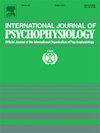认知干扰解决中内在连接网络内部和之间的改变
IF 2.5
3区 心理学
Q3 NEUROSCIENCES
引用次数: 0
摘要
认知干扰解决(CIR)是在存在干扰的情况下保持目标导向的注意力的过程。虽然CIR已经通过局部激活分析进行了广泛的研究,但其网络级动态研究仍然缺乏足够的方法多样性。在这项研究中,我们利用27名健康成人执行多源干扰任务(MSIT)的功能磁共振成像数据,研究了任务调制的内在连接网络(ICNs)及其在CIR过程中与详细子网分割的动态相互作用。我们应用高阶群独立成分分析(ICA)提取ICN子成分,然后通过任务调制成分识别和动态功能连通性分析来研究网络相互作用。结果表明,背侧注意网络(DAN)和认知控制网络(CCN)的激活和连通性增加,而默认模式网络(DMN)和边缘网络的激活和连通性下降。此外,视觉和小脑网络成为CIR的关键中介,因为DAN和CCN加强了它们与这些网络的连接,而不是直接相互作用。此外,网络重构模式表明躯体运动网络和CCN内部的功能分离,表明专门的子成分的贡献。这些发现提供了对CIR过程中ICN激活和动态网络间通信的详细理解,为应对认知干扰的大脑网络灵活重组提供了新的见解。本文章由计算机程序翻译,如有差异,请以英文原文为准。

Alterations within and between intrinsic connectivity networks in cognitive interference resolution
Cognitive interference resolution (CIR) is the process of maintaining goal-directed focus despite the presence of distractions. While CIR has been extensively studied through localized activation analyses, its network-level dynamics remain underexplored with sufficient methodological diversity.
In this study, we investigated the task-modulated intrinsic connectivity networks (ICNs) and their dynamic interactions with detailed subnetwork segmentation during CIR using fMRI data from 27 healthy adults performing the Multi-Source Interference Task (MSIT). We applied high-order group independent component analysis (ICA) to extract ICN subcomponents, followed by task-modulated component identification and dynamic functional connectivity analysis to examine network interactions.
Our results reveal that the dorsal attention network (DAN) and cognitive control network (CCN) show increased activation and connectivity, while the default mode network (DMN) and limbic network exhibit decreased activation and connectivity. Additionally, the visual and cerebellum networks emerge as key intermediaries in CIR, as DAN and CCN strengthen their connectivity with these networks rather than directly interacting with each other. Furthermore, network reconfiguration patterns suggest functional segregation within the somatomotor network and CCN, indicating specialized subcomponent contributions.
These findings provide a granular understanding of ICN activations and dynamic inter-network communication during CIR, offering new insights into the flexible reorganization of brain networks in response to cognitive interference.
求助全文
通过发布文献求助,成功后即可免费获取论文全文。
去求助
来源期刊
CiteScore
5.40
自引率
10.00%
发文量
177
审稿时长
3-8 weeks
期刊介绍:
The International Journal of Psychophysiology is the official journal of the International Organization of Psychophysiology, and provides a respected forum for the publication of high quality original contributions on all aspects of psychophysiology. The journal is interdisciplinary and aims to integrate the neurosciences and behavioral sciences. Empirical, theoretical, and review articles are encouraged in the following areas:
• Cerebral psychophysiology: including functional brain mapping and neuroimaging with Event-Related Potentials (ERPs), Positron Emission Tomography (PET), Functional Magnetic Resonance Imaging (fMRI) and Electroencephalographic studies.
• Autonomic functions: including bilateral electrodermal activity, pupillometry and blood volume changes.
• Cardiovascular Psychophysiology:including studies of blood pressure, cardiac functioning and respiration.
• Somatic psychophysiology: including muscle activity, eye movements and eye blinks.

 求助内容:
求助内容: 应助结果提醒方式:
应助结果提醒方式:


